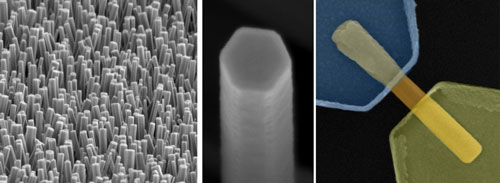| Dec 10, 2018 | |
Nanowire Memristor: a nanometric device to reproduce the synapses of the brain(Nanowerk News) Emulating and understanding the human brain is one of the most important challenges for modern technology: on the one hand, the ability to artificially reproduce the processing of brain signals is one of the cornerstones for the development of artificial intelligence, while on the other the understanding of the cognitive processes at the base of the human mind is still far away. |
|
| And the research published in Nature Communications ("Self-limited single nanowire systems combining all-in-one memristive and neuromorphic functionalities") by Gianluca Milano and Carlo Ricciardi, PhD student and professor, respectively, of the Applied Science and Technology Department of the Politecnico di Torino, represents a step forward in these directions. | |
| In fact, the study shows how it is possible to artificially emulate the activity of synapses, i.e. the connections between neurons that regulate the learning processes in our brain, in a single "nanowire" with a diameter thousands of times smaller than that of a hair. | |
 |
|
| Pristine state and forming process of single ZnO NW-based memristive devices. Left: SEM image of ZnO NW arrays and, middle, detail of a vertically aligned and hexagonal-shaped ZnO NW after the growth process. Right: SEM image (in false colours) of a single NW memristive device. The single isolated ZnO NW (orange) is contacted by an Ag electrode (blue) and a Pt electrode (yellow). (© NPG) | |
| It is a crystalline nanowire that takes the memristor, the electronic device able to artificially reproduce the functions of biological synapses, to a more performing level. Thanks to the use of nanotechnologies, which allow the manipulation of matter at the atomic level, it was for the first time possible to combine into one single device the synaptic functions that were individually emulated through specific devices. | |
| For this reason, the nanowire allows an extreme miniaturisation of the "memristor", significantly reducing the complexity and energy consumption of the electronic circuits necessary for the implementation of learning algorithms. | |
| Starting from the theorisation of the “memristor” in 1971 by Prof. Leon Chua - now visiting professor at the Politecnico di Torino, who was conferred an honorary degree by the University in 2015 - this new technology will not only allow smaller and more performing devices to be created for the implementation of increasingly "intelligent" computers, but is also a significant step forward for the emulation and understanding of the functioning of the brain. | |
| “The nanowire memristor - said Carlo Ricciardi - represents a model system for the study of physical and electrochemical phenomena that govern biological synapses at the nanoscale. |
| Source: Politecnico di Torino | |
|
Subscribe to a free copy of one of our daily Nanowerk Newsletter Email Digests with a compilation of all of the day's news. |
